Early Fault Diagnosis for Planetary Gearbox Based Wavelet Packet Energy and Modulation Signal Bispectrum Analysis
Abstract
:1. Introduction
2. Wavelet Packet Transform and Energy Feature Extraction
3. Modulation Signal Bispectrum
4. The Proposed Method Based on WPT and MSB
- Step 1:
- Carry out WPT to process the vibration signal in order to separate it into different time-frequency subspaces.
- Step 2:
- Calculate the WPE matrix in time-frequency subspaces.
- Step 3:
- Select relatively high energy vectors from the WPE matrix.
- Step 4:
- Apply an inverse WPT to the selected bands to obtain reconstructed signal.
- Step 5:
- Calculate MSB of the reconstructed signal to extract the fault characteristic frequency.
5. Experimental Verification
5.1. Experimental Setup
5.2. The Fault Diagnosis of the Sun Gear Chipped Tooth
5.3. The Fault Diagnosis of the Planetary Gear Bearing
6. Conclusions
Author Contributions
Funding
Conflicts of Interest
References
- Li, Z.; Jiang, Y.; Hu, C.; Peng, Z. Recent progress on decoupling diagnosis of hybrid failures in gear transmission systems using vibration sensor signal: A review. Measurement 2016, 90, 4–19. [Google Scholar] [CrossRef]
- Glowacz, A.; Glowacz, W.; Glowacz, Z.; Kozik, J. Early fault diagnosis of bearing and stator faults of the single-phase induction motor using acoustic signals. Measurement 2018, 113, 1–9. [Google Scholar] [CrossRef]
- Chen, X.; Feng, F.; Zhang, B. Weak Fault Feature Extraction of Rolling Bearings Based on an Improved Kurtogram. Sensors 2016, 16, 1482. [Google Scholar] [CrossRef] [PubMed]
- Saucedo-Dorantes, J.J.; Delgado-Prieto, M.; Ortega-Redondo, J.A.; Osornio-Rios, R.A.; Romero-Troncoso, R.D. Multiple-fault detection methodology based on vibration and current analysis applied to bearings in induction motors and gearboxes on the kinematic chain. Shock Vib. 2016, 2016, 5467643. [Google Scholar] [CrossRef]
- Lee, D.H.; Ahn, J.H.; Koh, B.H. Fault detection of bearing systems through EEMD and optimization algorithm. Sensors 2017, 17, 2477. [Google Scholar] [CrossRef] [PubMed]
- Ge, M.; Wang, J.; Zhang, F.; Bai, K.; Ren, X. A novel fault diagnosis method of rolling bearings based on AFEWT-KDEMI. Entropy 2018, 20, 445. [Google Scholar] [CrossRef]
- Cui, L.; Zhang, Y.; Zhang, F.; Zhang, J.; Lee, S. Vibration response mechanism of faulty outer race rolling element bearings for quantitative analysis. J. Sound Vib. 2016, 364, 67–76. [Google Scholar] [CrossRef]
- Benmoussa, S.; Djeziri, M.A. Remaining useful life estimation without needing for prior knowledge of the degradation features. Iet. Sci. Meas. Technol. 2017, 11, 1071–1078. [Google Scholar] [CrossRef]
- Liang, X.; Zuo, M.J.; Feng, Z. Dynamic modeling of gearbox faults: A review. Mech. Syst. Signal Process. 2018, 98, 852–876. [Google Scholar] [CrossRef]
- Pacheco, F.; Cerrada, M.; Cabrera, D.; Li, C.; Zuria, G. A statistical comparison of neuroclassifiers and feature selection methods for gearbox fault diagnosis under realistic conditions. Neurocomputing 2016, 194, 192–206. [Google Scholar] [CrossRef]
- Djeziri, M.A.; Ananou, B.; Ouladsine, M. Data driven and model based fault prognosis applied to a mechatronic system. In Proceedings of the 4th International Conference on Power Engineering, Energy and Electrical Drives, Istanbul, Turkey, 13–17 May 2013. [Google Scholar]
- Xiao, B.; Huo, M.; Yang, X.; Zhang, Y. Fault-tolerant attitude stabilization for satellites without rate sensor. IEEE. Technol. Ind. Electron. 2015, 62, 7191–7202. [Google Scholar] [CrossRef]
- Sui, W.; Osman, S.; Wang, W. An adaptive envelope spectrum technique for bearing fault detection. Meas. Sci. Technol. 2014, 25, 095004. [Google Scholar] [CrossRef]
- Feng, J.; Lei, Y.; Shan, H.; Lin, J. Early fault diagnosis of bearings using an improved spectral kurtosis by maximum correlated kurtosis deconvolution. Sensors 2015, 15, 29363–29377. [Google Scholar]
- Pachori, R.B.; Nishad, A. Cross-terms reduction in the Wigner–Ville distribution using tunable-Q wavelet transform. Signal Process. 2016, 120, 288–304. [Google Scholar] [CrossRef]
- Zhang, Y.G.; Zhang, C.H.; Sun, J.B.; Guo, J.J. Improved wind speed prediction using empirical mode decomposition. Adv. Electr. Comput. Eng. 2018, 18, 3–10. [Google Scholar] [CrossRef]
- Zhang, C.; Li, Z.; Chen, S.; Wang, J.; Zhang, X. Optimised ensemble empirical mode decomposition with optimised noise parameters and its application to rolling element bearing fault diagnosis. Insight 2016, 58, 494–501. [Google Scholar] [CrossRef]
- Li, D.; Liang, Y.; Feng, Q.; Song, G. Load monitoring of the pin-connected structure based on wavelet packet analysis using piezoceramic transducers. Measurement 2017, 122, 638–647. [Google Scholar] [CrossRef]
- Chen, B.; Wang, X.; Yan, W.; Tian, H.; Xiao, W.; Chen, F.; Liu, H. A RSSD fault diagnosis method for rolling bearings based on optimization of quality factors and reconstruction of sub-bands. J. Xian Jiaotong Univ. 2018, 52, 70–76. [Google Scholar]
- He, Q. Vibration signal classification by wavelet packet energy flow manifold learning. J. Sound Vib. 2013, 332, 1881–1894. [Google Scholar] [CrossRef]
- Wang, Y.; Xu, G.; Lin, L.; Jiang, K. Detection of weak transient signals based on wavelet packet transform and manifold learning for rolling element bearing fault diagnosis. Mech. Syst. Signal Process. 2015, 54–55, 259–276. [Google Scholar] [CrossRef]
- Gómez, M.; Corral, E.; Castejón, C.; Garciaprada, J. Effective crack detection in railway axles using vibration signals and WPT energy. Sensors 2018, 18, 1603. [Google Scholar] [CrossRef] [PubMed]
- Zhou, S.; Qian, S.; Chang, W.; Xiao, Y.; Cheng, Y. A novel bearing multi-fault diagnosis approach based on weighted permutation entropy and an improved SVM ensemble classifier. Sensors 2018, 18, 1934. [Google Scholar] [CrossRef] [PubMed]
- Gu, F.; Shao, Y.; Hu, N.; Naid, A.; Ball, A.D. Electrical motor current signal analysis using a modified bispectrum for fault diagnosis of downstream mechanical equipment. Mech. Syst. Signal Process. 2011, 25, 360–372. [Google Scholar] [CrossRef]
- Zhang, R.; Gu, F.; Mansaf, H.; Wang, T.; Ball, A.D. Gear wear monitoring by modulation signal bispectrum based on motor current signal analysis. Mech. Syst. Signal Process. 2017, 94, 202–213. [Google Scholar] [CrossRef]
- Tian, X.; Gu, J.X.; Rehab, I.; M.Abdalla, G.; Gu, F.; Ball, A.D. A robust detector for rolling element bearing condition monitoring based on the modulation signal bispectrum and its performance evaluation against the Kurtogram. Mech. Syst. Signal Process. 2018, 100, 167–187. [Google Scholar] [CrossRef]
- Dequeiroz, R.L.; Rao, K.R. Time-varying lapped transforms and wavelet packets. IEEE Technol. Signal Process. 1993, 41, 3293–3305. [Google Scholar] [CrossRef]
- Paiva, H.M.; Galvão, R.K.H. Wavelet-packet identification of dynamic systems in frequency subbands. Signal Process. 2006, 86, 2001–2008. [Google Scholar] [CrossRef]
- Liu, B. Selection of wavelet packet basis for rotating machinery fault diagnosis. J. Sound Vib. 2005, 284, 567–582. [Google Scholar] [CrossRef]
- Kim, E.Y.; Lee, Y.J.; Lee, S.K. Heath monitoring of a glass transfer robot in the mass production line of liquid crystal display using abnormal operating sounds based on wavelet packet transform and artificial neural network. J. Sound Vib. 2012, 331, 3412–3427. [Google Scholar] [CrossRef]
- Wang, D.; Tse, P.W.; Tsui, K.L. An enhanced Kurtogram method for fault diagnosis of rolling element bearings. Mech. Syst. Signal Process. 2013, 35, 176–199. [Google Scholar] [CrossRef]

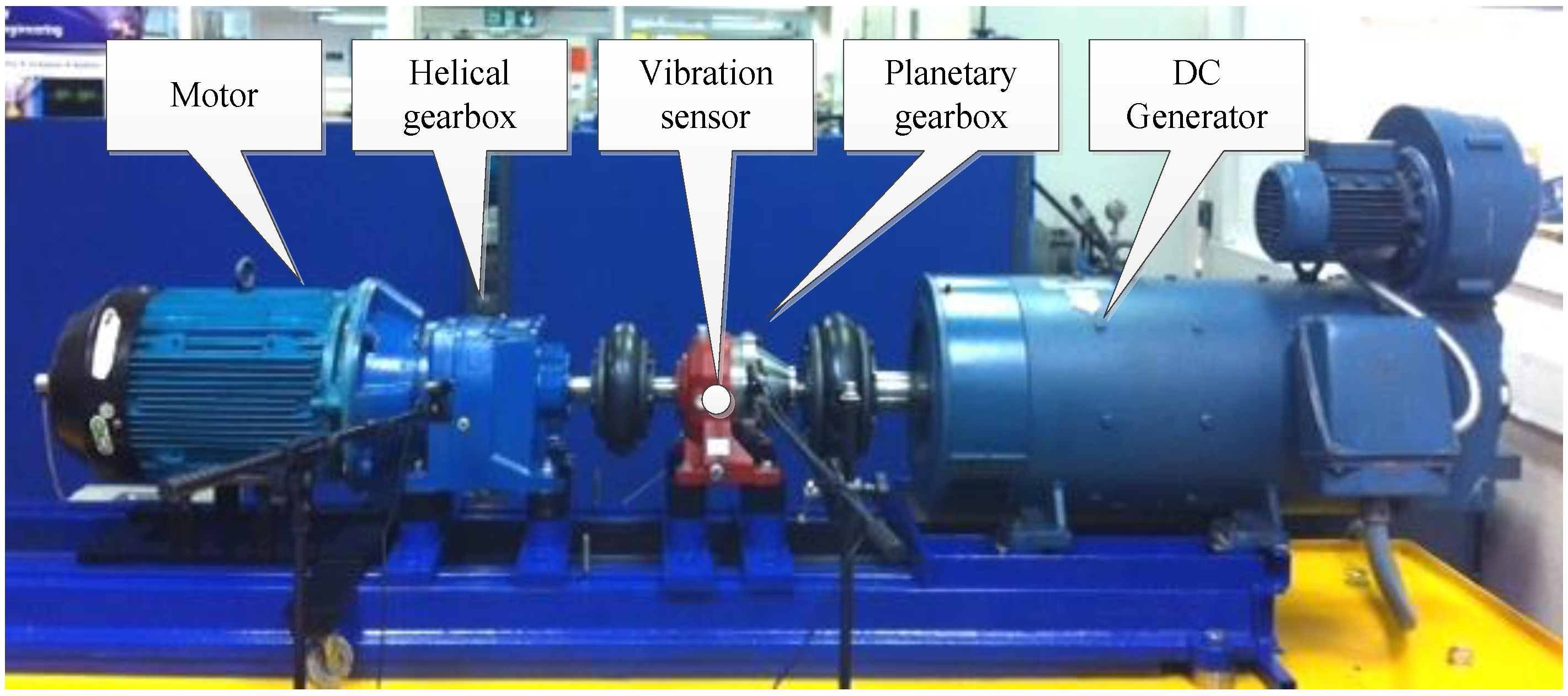
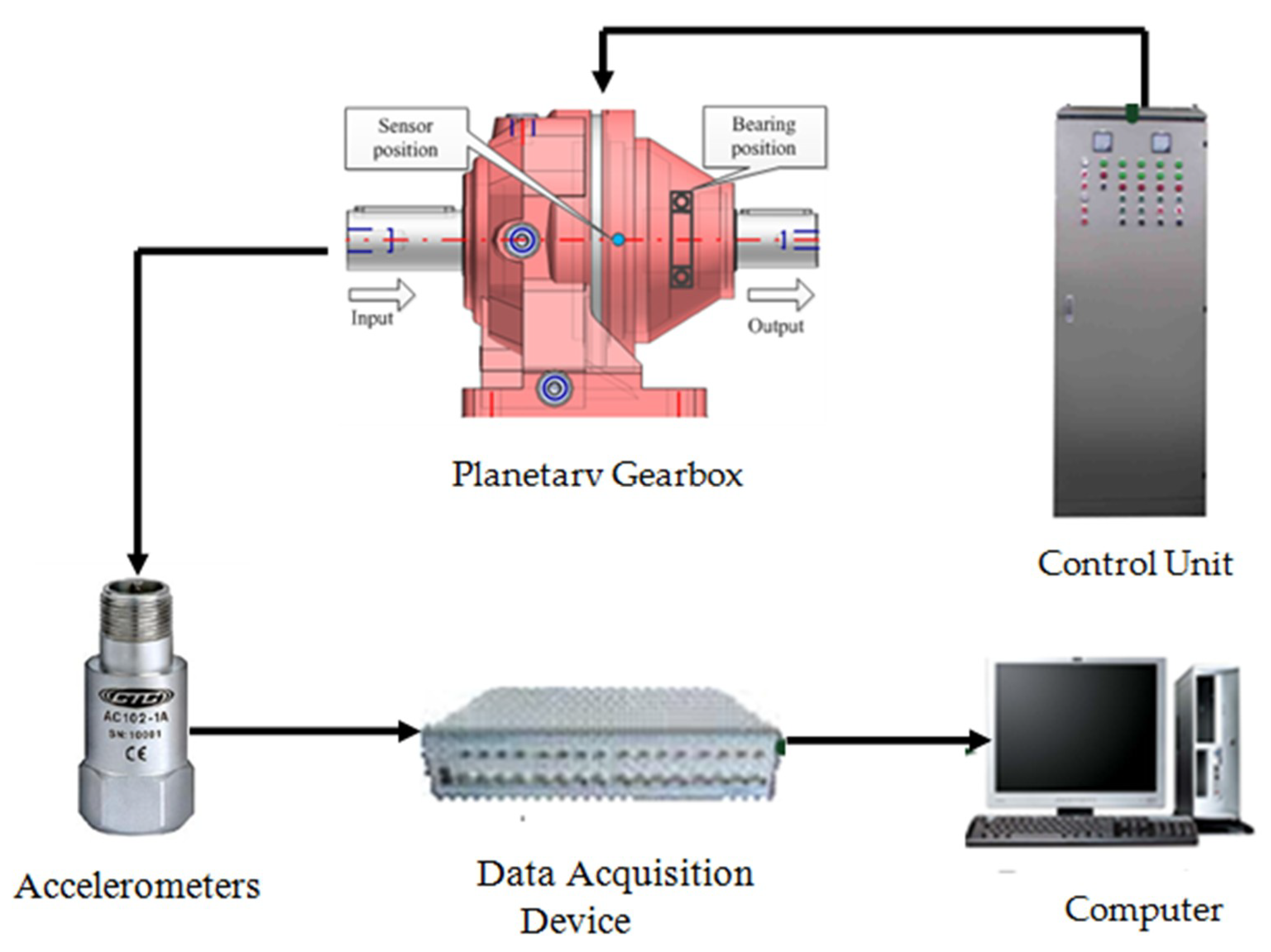
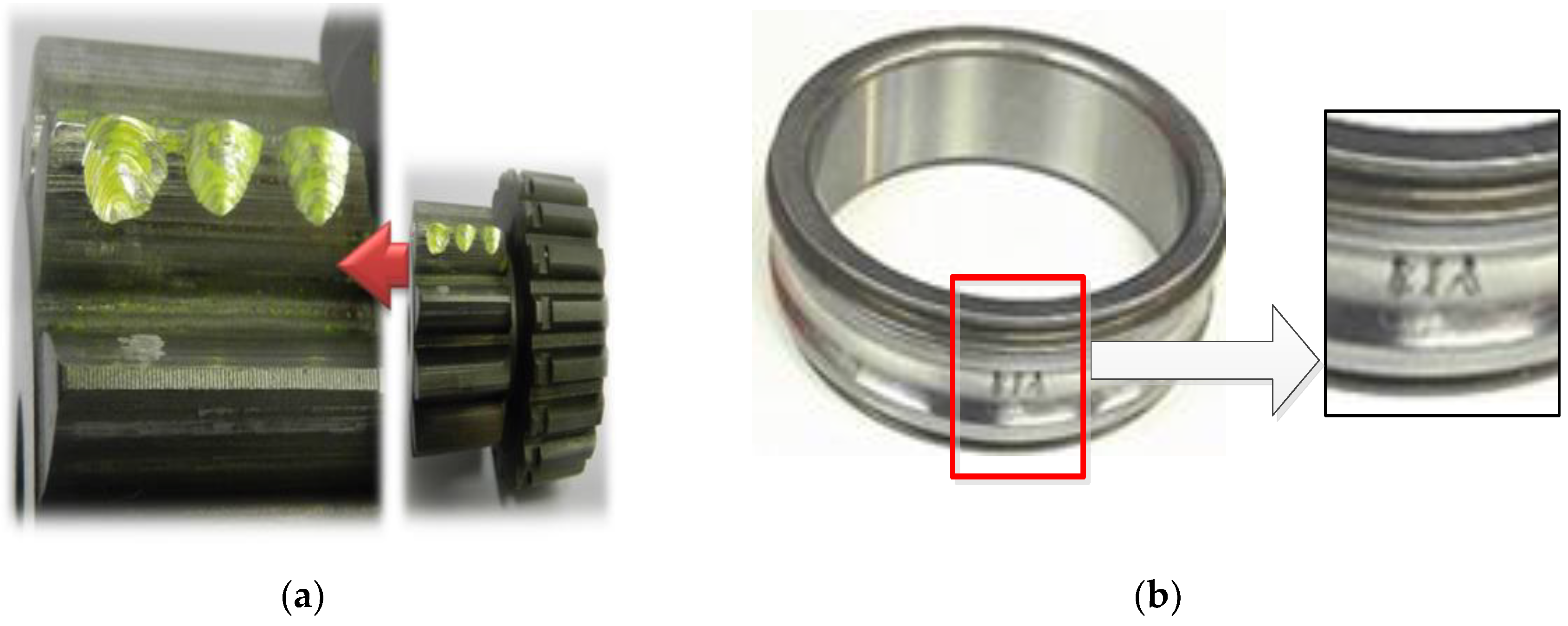
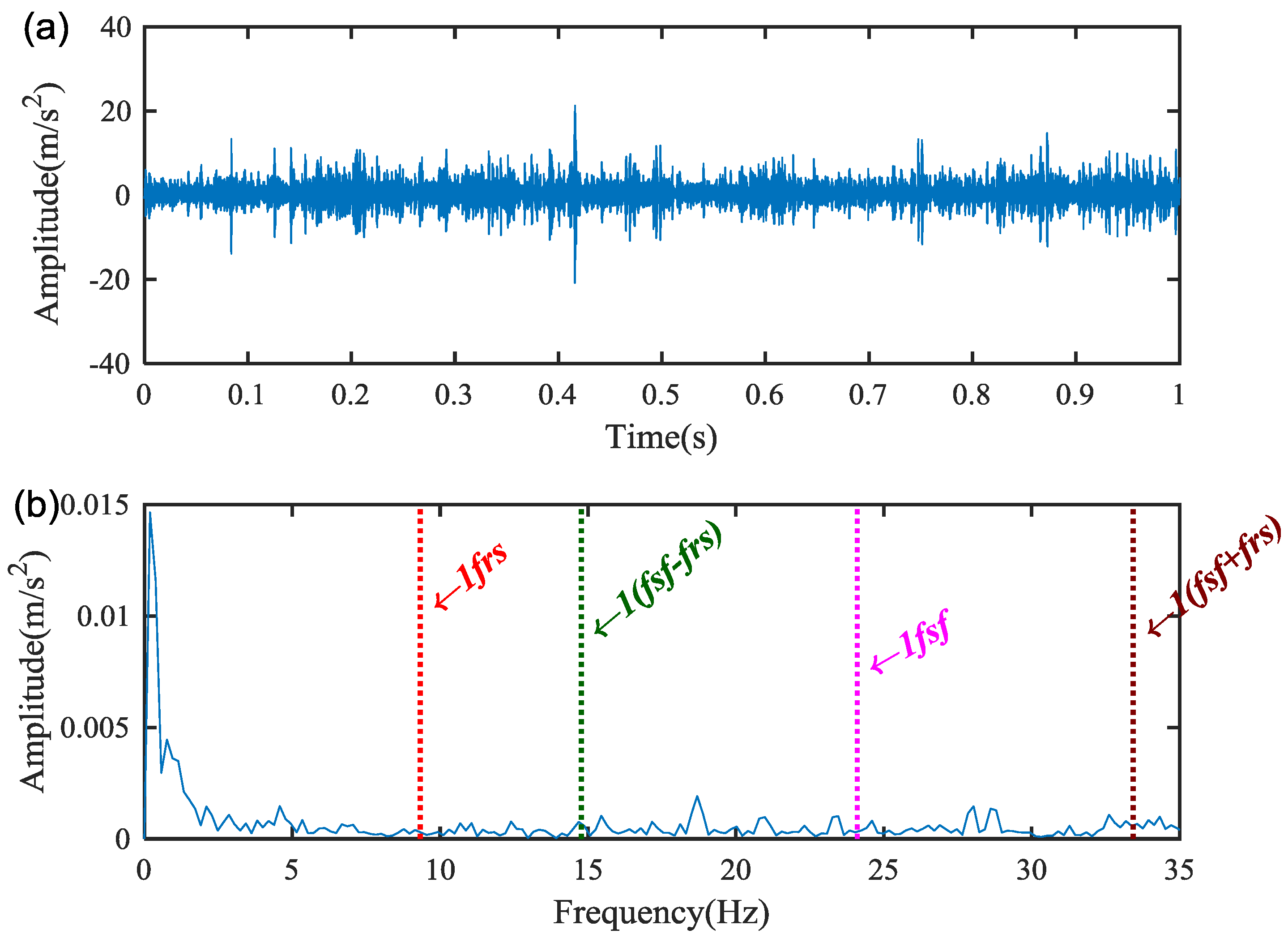
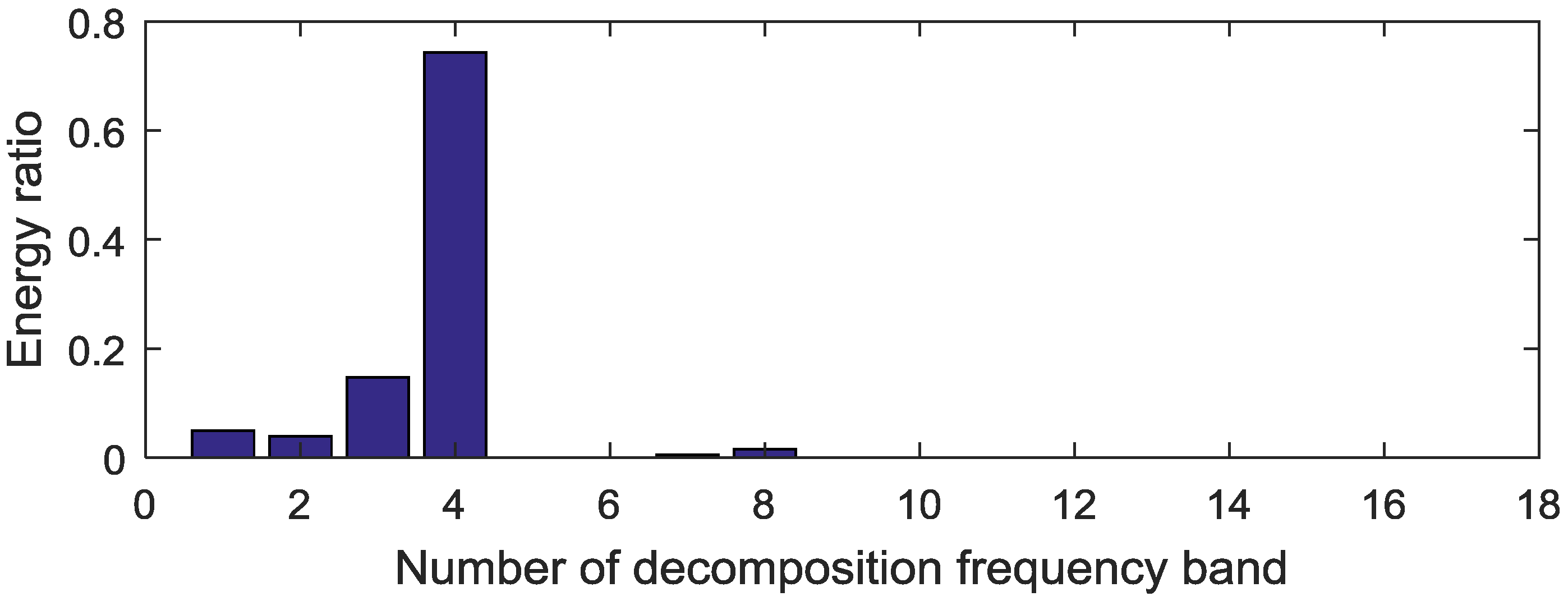
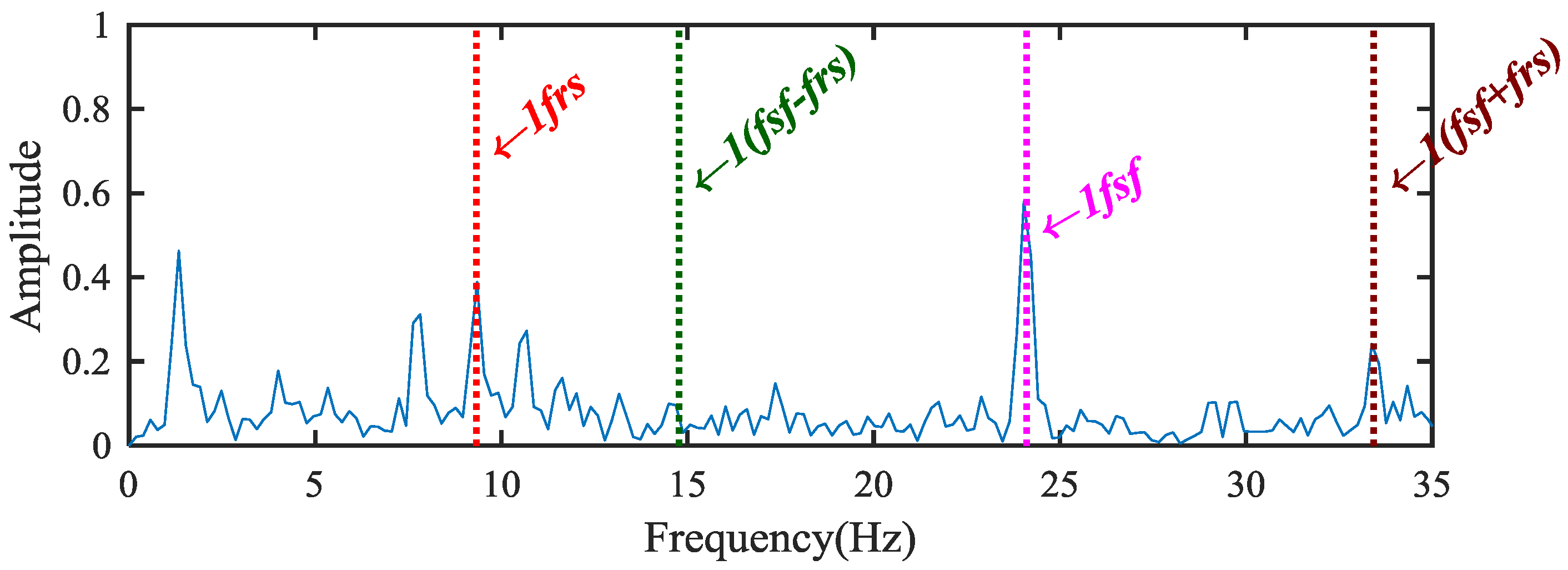
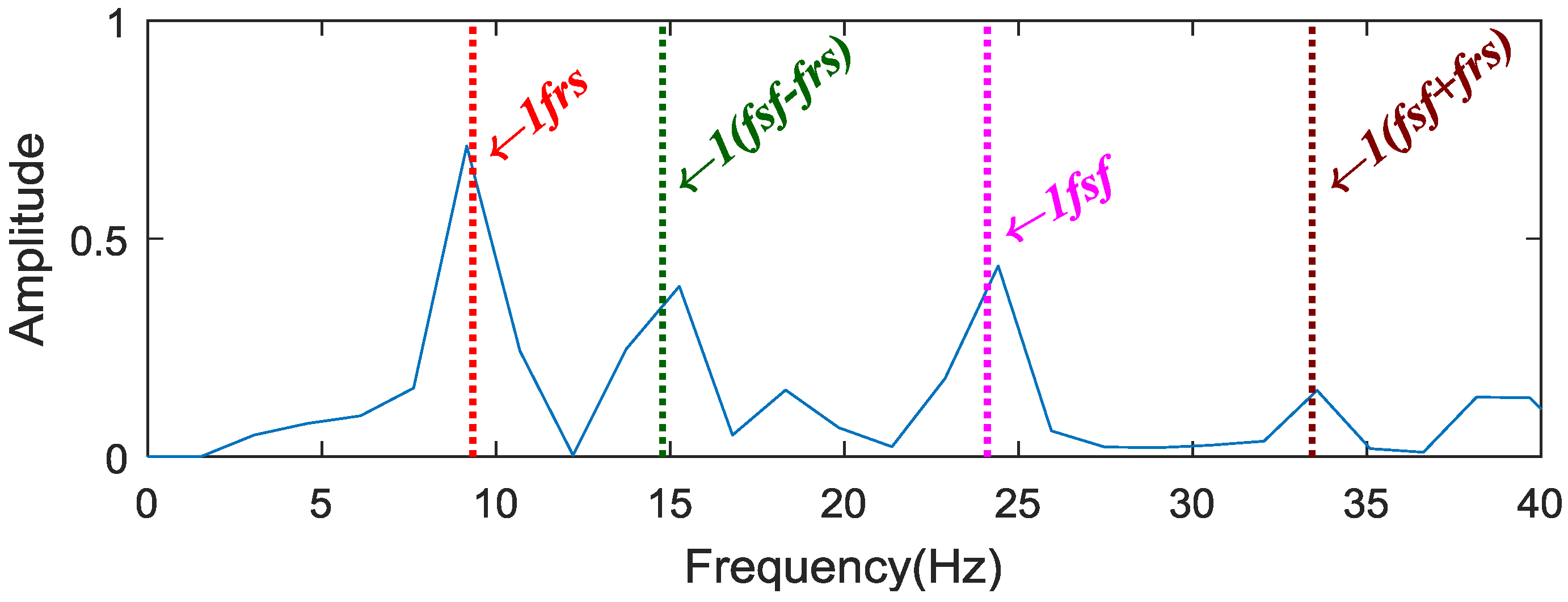
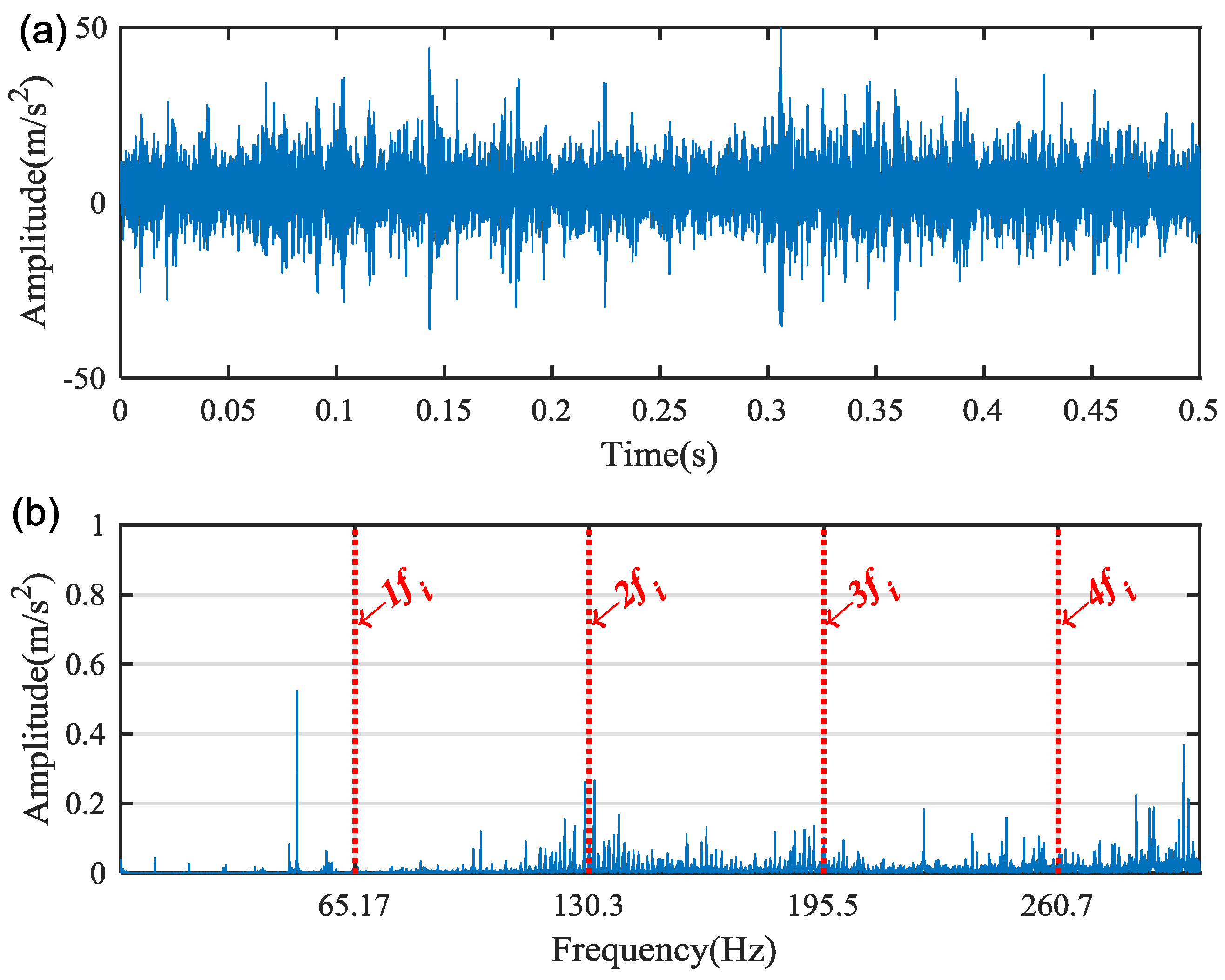
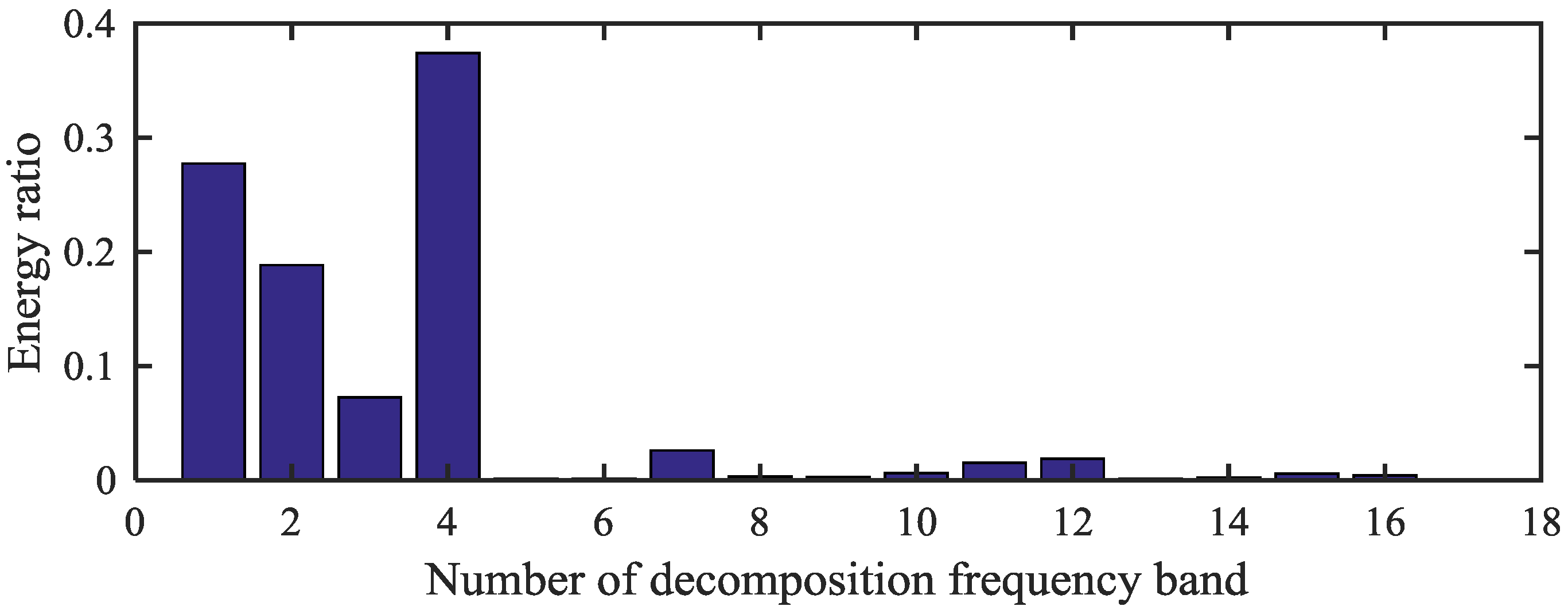

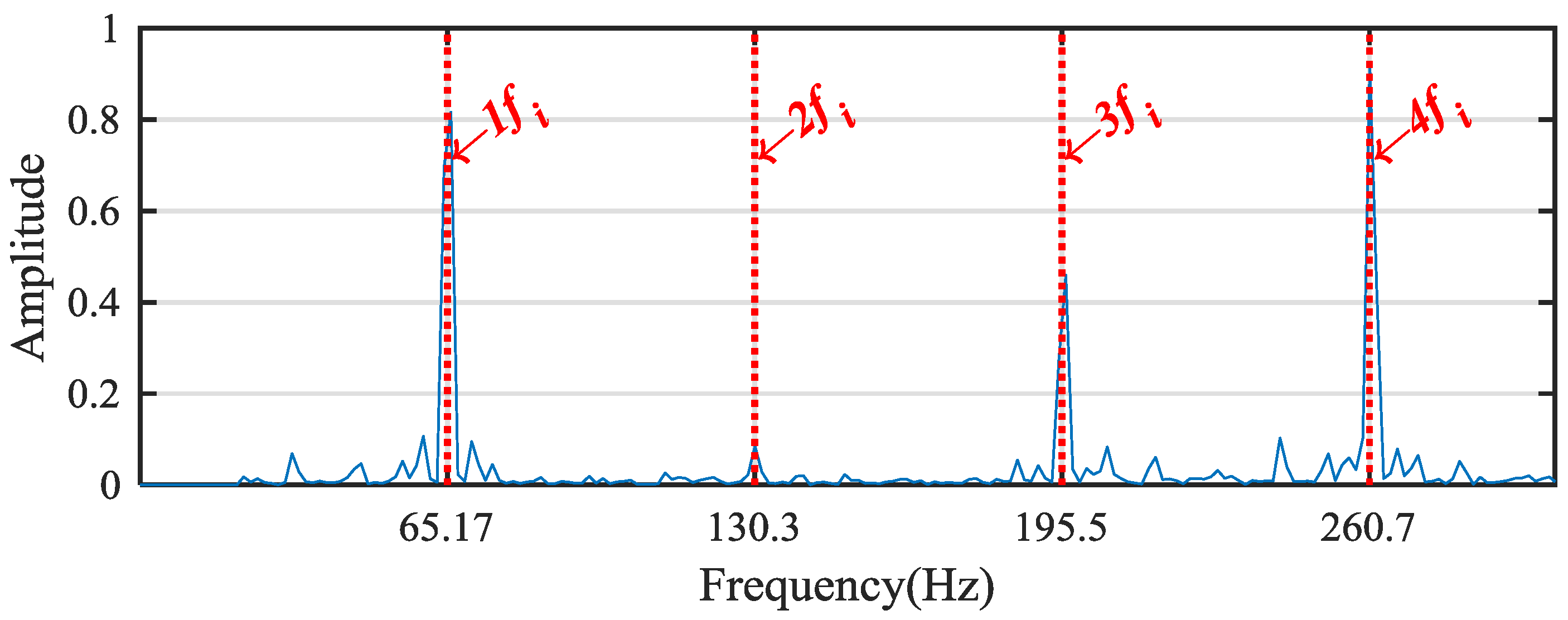
| Gear | Number of Teeth | Characteristic Frequency (Hz) | |
|---|---|---|---|
| Sun gear | 10 | 24.10 | |
| Planet gears(number) | 26(3) | 9.77 | |
| Ring gear | 62 | 3.89 | |
| Bearing Designation | Ball Numbers d (mm) | Pitch Diameter(mm) | Ball Number z | Contact Angle β |
| 12 | 54 | 7.9 | ||
| 6008 | ||||
| 49.25 | 65.17 | 33.60 | 4.10 |
| Serial Number | Node Situation | Frequency/Hz |
|---|---|---|
| 1st | node [4,0] | 0–6000 Hz |
| 2nd | node [4,1] | 6000–12,000 Hz |
| 3rd | node [4,2] | 12,000–18,000 Hz |
| 4th | node [4,3] | 18,000–24,000 Hz |
| 5th | node [4,4] | 24,000–30,000 Hz |
| 6th | node [4,5] | 30,000–36,000 Hz |
| 7th | node [4,6] | 36,000–42,000 Hz |
| 8th | node [4,7] | 42,000–48,000 Hz |
| 9th | node 4,8] | 48,000–54,000 Hz |
| 10th | node [4,9] | 54,000–60,000 Hz |
| 11th | node [4,10] | 60,000–66,000 Hz |
| 12th | node [4,11] | 66,000–72,000 Hz |
| 13th | node [4,12] | 72,000–78,000 Hz |
| 14th | node [4,13] | 78,000–84,000 Hz |
| 15th | node [4,14] | 84,000–90,000 Hz |
| 16th | node [4,15] | 90,000–96,000 Hz |
© 2018 by the authors. Licensee MDPI, Basel, Switzerland. This article is an open access article distributed under the terms and conditions of the Creative Commons Attribution (CC BY) license (http://creativecommons.org/licenses/by/4.0/).
Share and Cite
Guo, J.; Shi, Z.; Li, H.; Zhen, D.; Gu, F.; Ball, A.D. Early Fault Diagnosis for Planetary Gearbox Based Wavelet Packet Energy and Modulation Signal Bispectrum Analysis. Sensors 2018, 18, 2908. https://doi.org/10.3390/s18092908
Guo J, Shi Z, Li H, Zhen D, Gu F, Ball AD. Early Fault Diagnosis for Planetary Gearbox Based Wavelet Packet Energy and Modulation Signal Bispectrum Analysis. Sensors. 2018; 18(9):2908. https://doi.org/10.3390/s18092908
Chicago/Turabian StyleGuo, Junchao, Zhanqun Shi, Haiyang Li, Dong Zhen, Fengshou Gu, and Andrew D. Ball. 2018. "Early Fault Diagnosis for Planetary Gearbox Based Wavelet Packet Energy and Modulation Signal Bispectrum Analysis" Sensors 18, no. 9: 2908. https://doi.org/10.3390/s18092908







